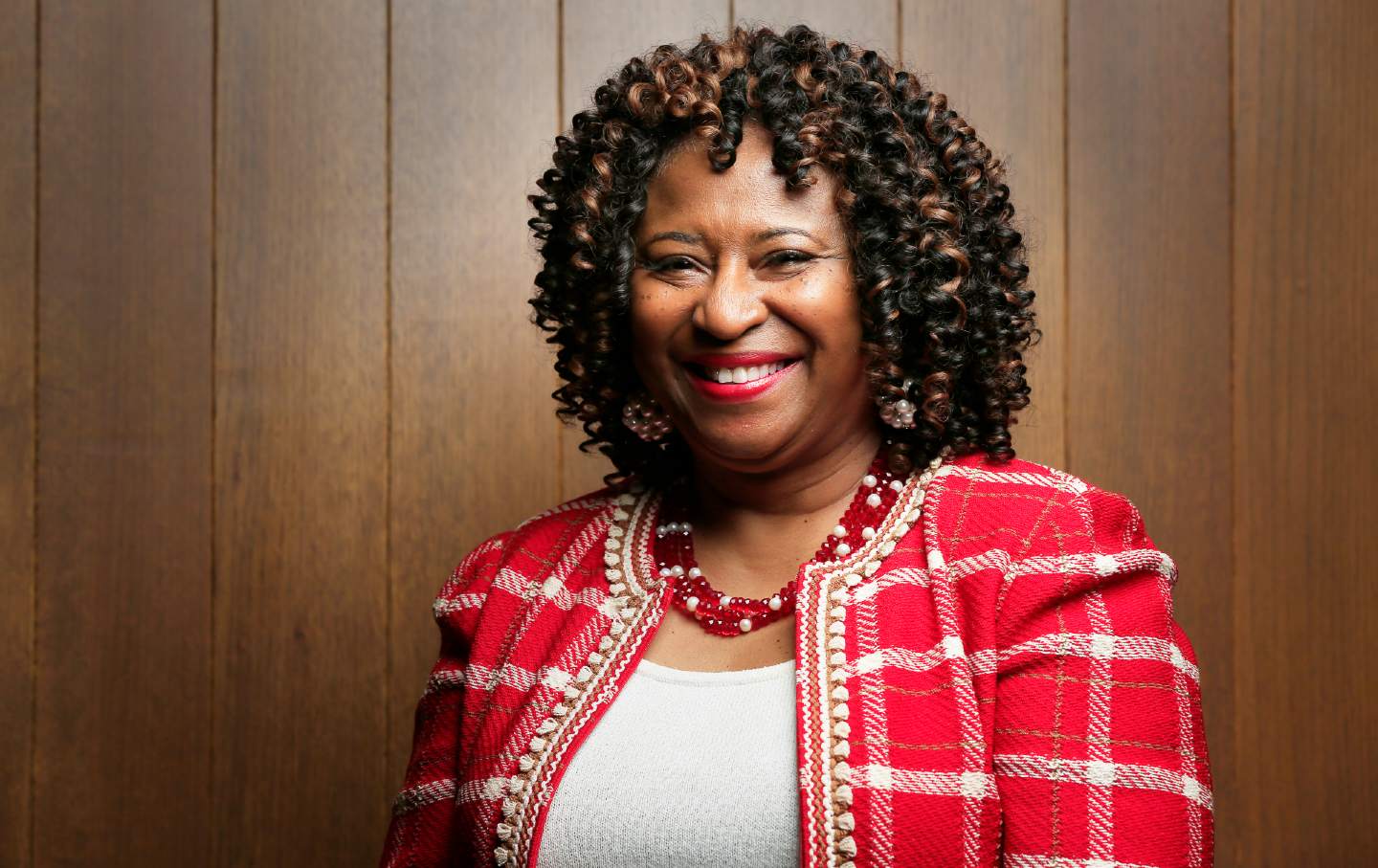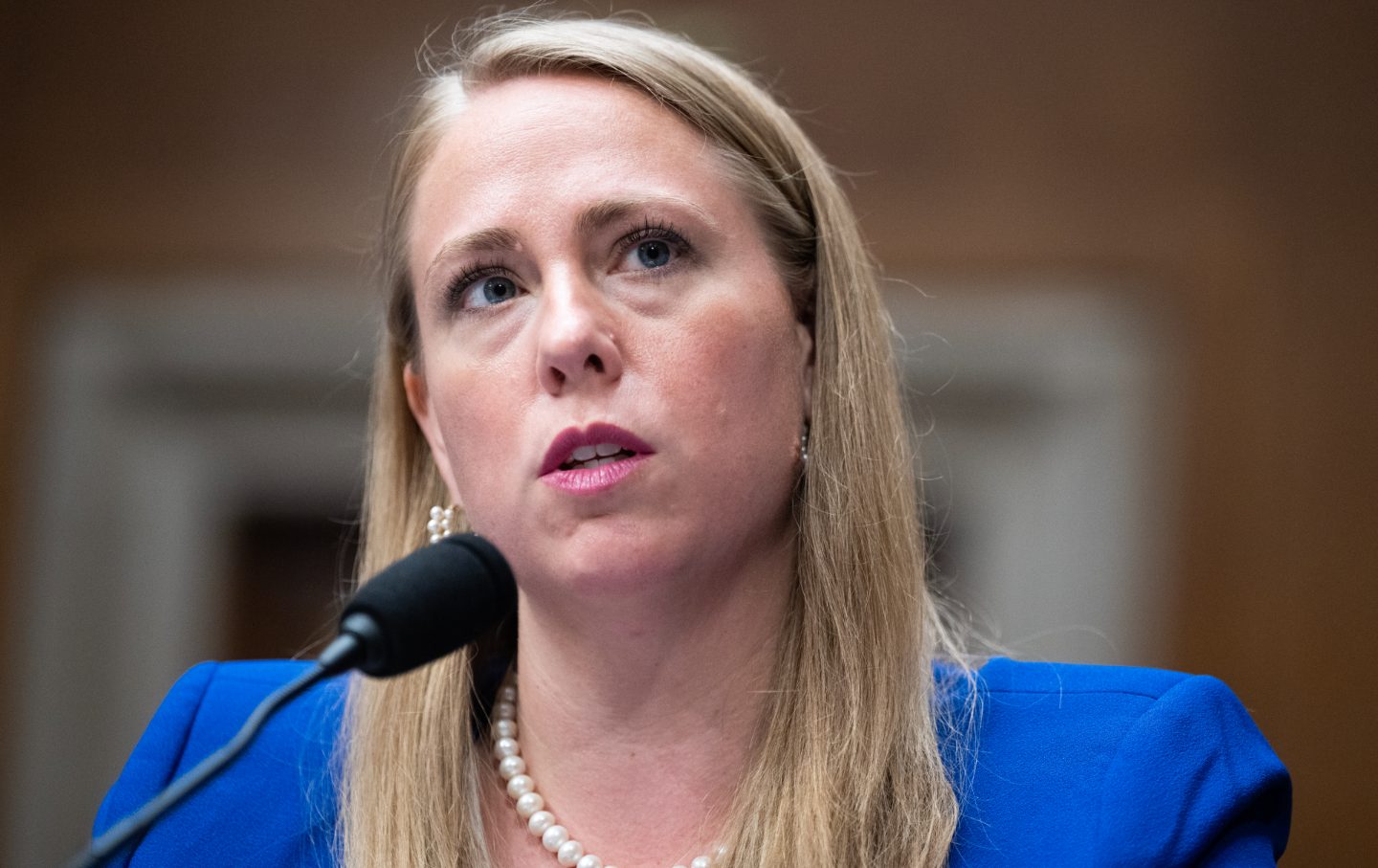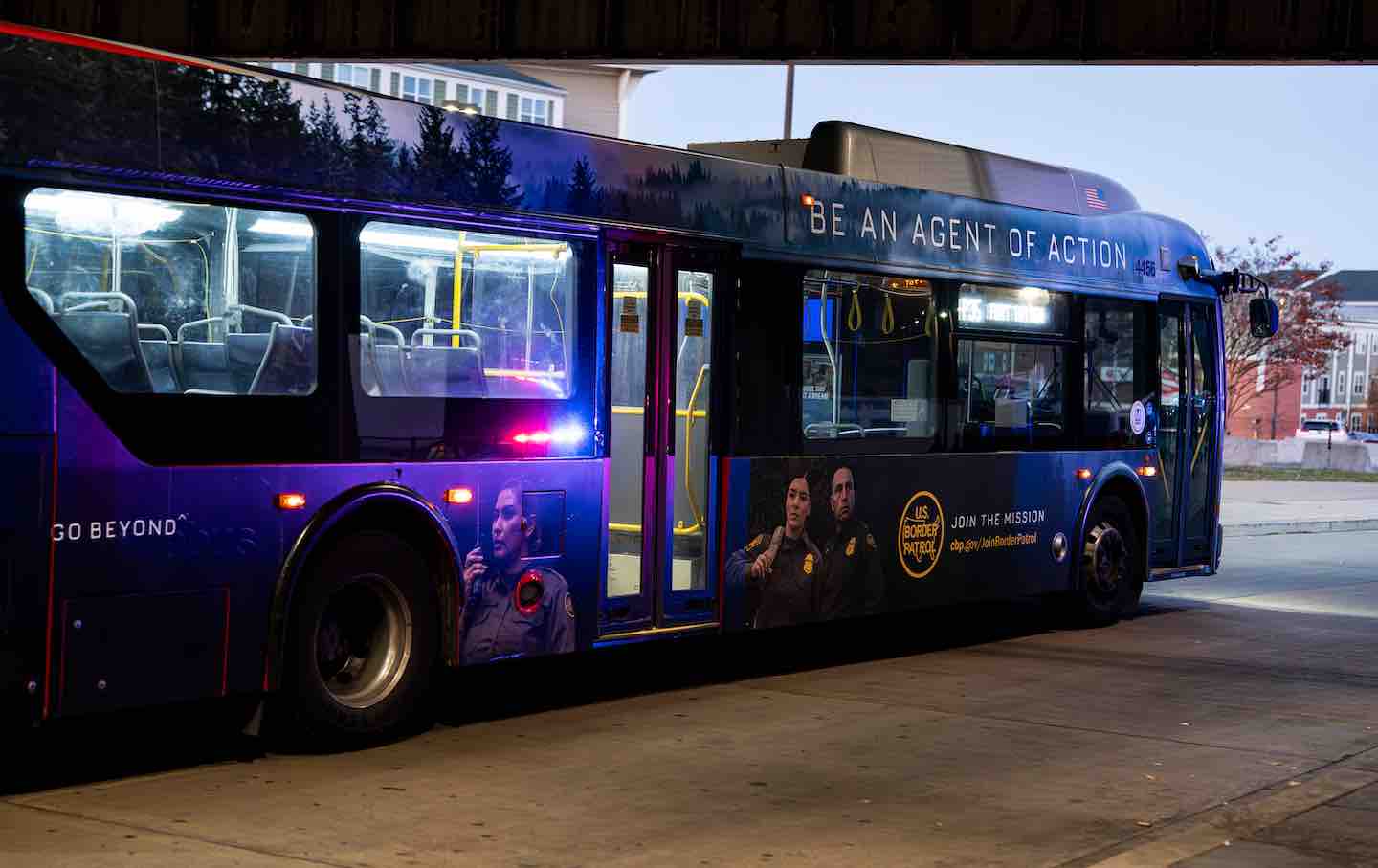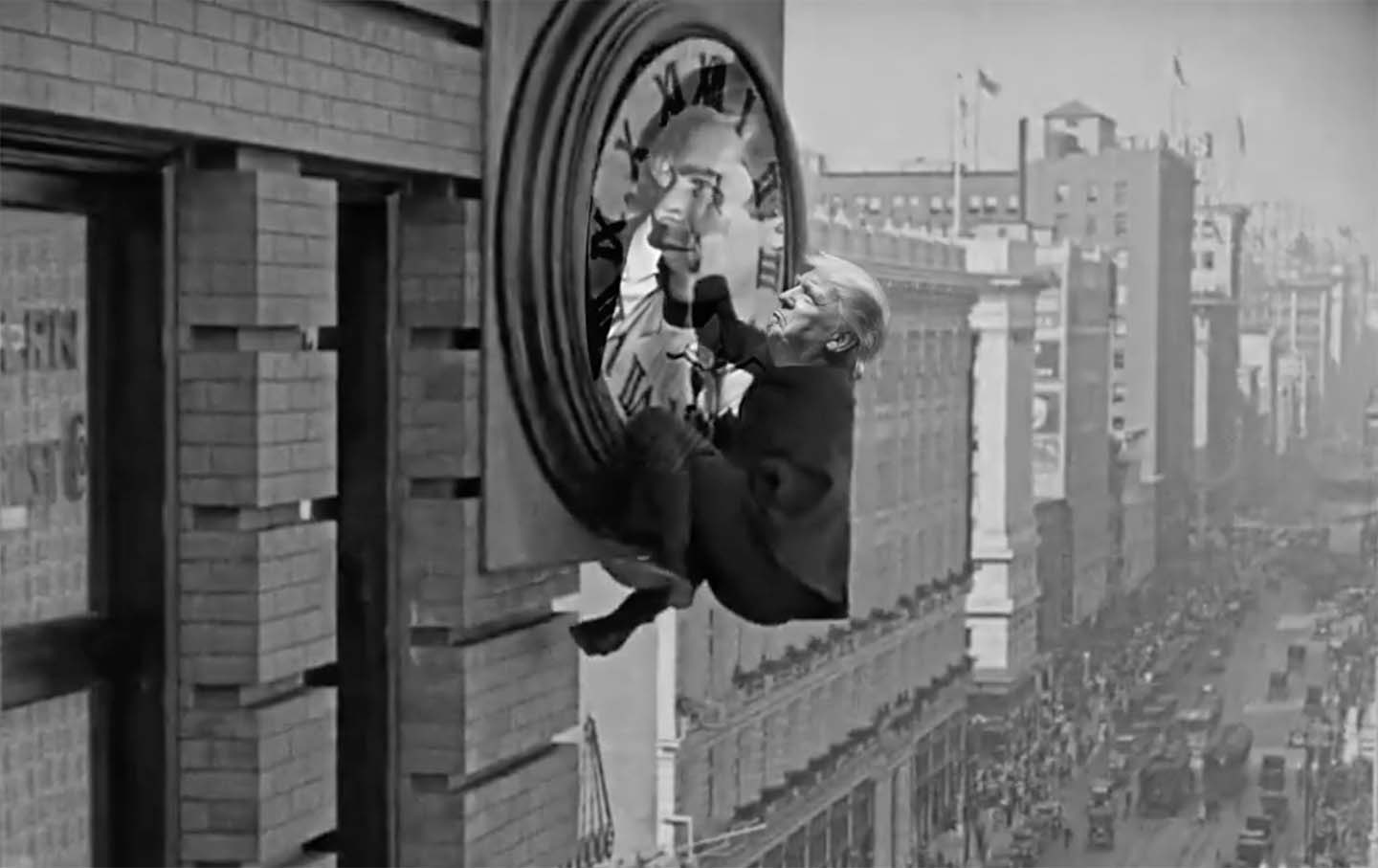The Backlash Comes for Oakland’s Progressive Prosecutor
Pamela Price, the Alameda County DA, is fighting a recall vote and to defend her unwavering refusal to over-criminalize young people.

Pamela Price, Alameda County district attorney.
(Lea Suzuki / The San Francisco Chronicle via Getty Images)
One night last July, in the hillside neighborhood of Montclair, California, Alameda County District Attorney Pamela Price faced a church overflowing with people, many of whom blamed her for the crime in their neighborhoods, and said, “I am the person who is not supposed to be here.”
Price was talking about her childhood. She described how she was arrested as a teenager, how she spent time in foster care, and how the criminal legal system might have been her future if things had gone slightly different.
Price—battling a recall attempt that kicked off just months after she took office as Oakland’s first Black female DA—had shown up to the town hall to defend her vision for the office, which included an unwavering refusal to over-criminalize young people. She ran on a 10-point plan to reform criminal justice. And since taking office, she has instituted policies to keep 16- and 17-year-olds in the youth justice system instead of transferring them to adult prisons and reevaluated how the county treats young adults between the ages of 18 and 25. These issues, Price said, were what had inspired her to run for DA in the first place. She told the crowd, “When I looked at our racial disparities for our young people in Alameda County, I could not look away.”
Price was making this appeal in enemy territory. Montclair, whose location abutting a freeway may have made it a target for theft, had not voted for her. Neither had the rest of the Oakland Hills, where handsome Craftsman homes and tree-lined streets perch high above the much poorer city with which they share a chief prosecutor. And so, after the DA spoke about racial disparities in youth justice—87 percent of children in the county’s juvenile system are Black or Latino—and emphasized her belief in redemption for young people, a member of the neighborhood association that hosted the event took the mic and asked about “one of the elephants in the room”: a series of recent robberies allegedly committed by teenagers. Rumors had been going around that Price’s office had let the young people go without so much as a charge.
The issue of youth crime has become a flash point in Oakland politics. Local news stories of retail theft, robberies, and a small number of serious crimes have captured public attention. People grimace over the news that more than half of Oakland’s students are chronically absent from school, double the national average. This spring, The Berkeley Scanner, a local paper that has been relentlessly critical of Price, broke the news that the DA had decided to keep in the juvenile system a young man who was 17 when he opened fire at a birthday party, killing teenage brothers Angel and Jazy Soleto. This outraged members of the Soleto family, who later held a press conference supporting the recall.
Citizens at the town hall—and especially those backing the recall effort—are looking to the DA to use her prosecutorial powers to halt what they see as a crime wave. “It has gotten out of hand,” one attendee told local news outside the event. Violent crime was up in Oakland in 2023, sparking talks of a “crime surge,” though homicide numbers were lower than in 2022; overall crime is now down 33 percent this year, with reduced rates of homicide, assault, and burglary. Only robbery numbers are up. Still, residents are frustrated at the feeling that nothing is being done to stop young people who commit crimes from developing into violent and unaccountable older people.
Price, meanwhile, wants people to see how the system’s traditional response often forges broken adults as well. With her invocation of her younger self, the DA was asking the town hall attendees to consider an alternative path for young people who have committed crimes. Given the right guidance and resources, she argues, someone they see as a threat now could grow up to become someone like her. In these differing visions lie the fundamental problem: How should the state meaningfully intervene in a young person’s life? What is the line between doing nothing and sending a kid to prison?
At one point, Price made a request to the audience in Montclair. She asked people to volunteer with the organizations and advocates who work with young people—plenty of whom went through the criminal legal system as teenagers themselves.
These youth justice workers are Price’s partners in trying to enact a system of youth justice that prioritizes care over criminalization. For the most part, they argue that the inflamed rhetoric around youth violence bears little resemblance to the teenagers and young adults they see in their daily work. “It feels like young people are being scapegoated,” Dieudonné Brou, the youth advocacy and program coordinator for the nonprofit Urban Peace Movement, told me.
“We’re hearing things like this is as bad as we’ve ever seen it—without any mention of the pandemic” and how it affected young people’s mental health and development, said Vamsey Palagummi, the managing director of Communities United for Restorative Youth Justice (CURYJ). Palagummi spent time in juvenile hall and on probation as a teen and now works on several county initiatives that focus on juvenile justice. The recall, he said, “has absolutely consumed our work daily, whether we’re in the commission spaces, whether we’re on the streets talking to folks.”
As recall proponents argue that the county’s approach toward youth crime has become too lenient, people who work on juvenile justice point to a complex mix of issues—legislative changes, resource allocation issues, trauma and mental health needs—that shape the system long before the district attorney comes into play. Ultimately, Price’s position, influential as it is, represents just one point in this matrix of courts, probation, youth services, and school.
“We also have to work in collaboration with many other actors who are able to intervene in many other points in this complex arena,” Cynthia Chandler, the Alameda County DA’s senior assistant policy chief, told me. “The DA can only intervene in a very small subset of harm.” And by definition, by the time the office is poised to intervene, that harm is almost always already done.
Palagummi said he appreciates that the DA’s office seems to be considering how to “provide the support that this young person needs, thinking outside of the box, working more with community members.” But he added, “Quite frankly, it’s not too different and drastic from the previous administration.” The problem, advocates argue, is not that the system has changed too much or too swiftly—it’s that it hasn’t changed enough.
In theory, at least, the juvenile justice system is predicated on the notion, backed by extensive scientific evidence, that young people are both less culpable for their actions and more capable of change than older adults. In this sense, it’s arguably the most compelling place to make the case for criminal legal reform, because it’s where the connections between societal and personal adversity—poverty, discrimination, disinvestment, abuse—and crime are the most obvious. “I don’t think that punishment is often, if ever, the answer for young folks,” said Celsa Snead, the executive director of Oakland’s Mentoring Center, whose work on violence prevention puts the organization into contact with adolescents caught up in the criminal legal system. “Rehabilitation, support, recognition, accountability—all those things are important.”
Popular
“swipe left below to view more authors”Swipe →With youth crime rates broadly declining since the mid-’90s, many states have tried to overhaul their youth justice systems, with varying degrees of success. Hawaii has touted its investments in community-based alternatives to youth incarceration; in 2022, the state announced that it no longer had any girls in juvenile detention. Maine, meanwhile, has attempted to transform its own approach to juvenile justice, but failed to provide and fund the services necessary to do so, leaving the state a “cautionary tale about the path to reform,” as a joint investigation by the Bangor Daily News and The New York Times put it.
In recent years, California has sought to overhaul its youth justice system, but its efforts at improvement have had mixed results. For a long time, young people convicted of serious offenses and kept in the juvenile system—in Alameda, about five people a year—would be sent to youth prisons run by the state’s Department of Juvenile Justice, which were rife with abuse, violence, and neglect. But a “realignment” law signed by California Governor Gavin Newsom in 2020 closed down the remaining facilities and put youth custody in the hands of counties—specifically, their probation departments. Now, teenagers from Oakland who would have once been sent to state facilities that could be hundreds of miles from the Bay Area are housed in juvenile detention centers much closer to home.
“While that’s a great thing, because DJJ [facilities] were essentially gladiator schools and really horrible places, and young people now have an opportunity to be closer to home, from my perspective, we’re replicating a lot of the harms that we worked really hard to rally against,” said Palagummi.
Since the realignment law, Palagummi and Brou have both remarked that judges are sending more kids to juvenile hall’s “secure track”—essentially, long-term confinement—causing them to worry that judges are expanding their criteria to determine which young people deserve this comparatively punitive outcome (their observations are borne out by Probation Department data).
At the same time, Palagummi said, not enough investments are being made in rehabilitative services. The problem is not in overall criminal legal funding levels, he said, but in how the money gets allocated: “We firmly believe that there are enough resources as it exists right now to provide robust therapeutic services.” On the realignment commission, he tries to advocate for using state juvenile funding “to focus more on diversion and community-based solutions” rather than things like overtime for probation staff, a significant chunk of the current budget. Palagummi also cited a therapist shortage combined with a higher level of need after the pandemic’s total disruption to kid’s school routines and mental health. “We do not have 24/7 clinicians—we don’t even have clinicians that can work regularly on the weekends,” he said.
Groups like Restorative Justice for Oakland Youth (RJOY) now have contracts to send “credible messengers,” formerly incarcerated adults who can act as mentors, into the juvenile detention facilities to work with young people. But these types of offerings are still a small part of the overall system, and they’re up against a daunting level of need. Teiahsha Bankhead, RJOY’s executive director, told me that RJOY ends up essentially providing critical post-release services for kids—holding welcome-home circles within 24 hours of release, helping them out with groceries, or calling them a rideshare so they can make it to a new job—without a formal contract. (RJOY is currently in the process of applying for one.) “I get kids who are from juvenile hall calling me, my staff telling us that they’re hungry,” she said. “I don’t care who’s funding us. We’re going to respond to that.”
Today, Brou is in his mid-30s, a UCLA graduate who runs a footwear company in addition to his work with Urban Peace Movement. The organization is a member of the Alameda County DA Accountability table, a coalition of local organizations that has pushed Price to, among other things, end the practice of transferring youth to the adult system in her first 100 days in office.
Brou knows intimately the harms that can befall a young person in an adult prison. After first coming into contact with the criminal legal system in middle school, Brou was arrested again at 18 and entered the California prison system about a year later. In total, he was incarcerated for seven years—an eternity for an 18-year-old, but a far shorter sentence than the average young person receives who has been transferred into the adult system, who, depending on the severity of their crime, might be incarcerated for multiple decades.
Soon after his arrival at High Desert State Prison, about 250 miles away from home, Brou was stabbed in his sleep during a riot. He remains traumatized by the experience. “When I’m sleeping, my family has to be cautious about the way they wake me up,” he said.
Brou said that any personal growth that he underwent in prison happened despite the environment. “There’s no real rehabilitation taking place in the adult system,” he told me. He also stressed that he had other advantages, like a family that cared for him and supported his efforts to enroll in school upon returning home, that many young people lack. “There’s plenty of other young men, I remember they would go home, and they would be back within a week,” he said. “I know I can easily be in those other guys’ situation where they’re going back to a traumatic environment where there’s no real support there for them, and then they’re going to be faced with those same decisions.”
Price has little sway over many aspects of the youth system, but one power the DA does enjoy is the ability to set charging priorities. In May 2023, Price released juvenile sentencing guidelines prohibiting transfers into the adult system absent “extraordinary circumstances” or a highly vulnerable victim. Chandler says that while the office is reviewing a small number of transfer requests made under Price’s predecessor, no new transfer processes have been initiated during her administration.
Price’s commitment to this directive has drawn fire from critics, including Brenda Grisham, one of the organizers of the recall effort. “I don’t care if they’re 16, 17—when they use an adult gun to kill somebody, they need to be held accountable more than the juvenile system gives them,” she told me. Grisham’s son was murdered in front of her in 2010, but his killer was never caught. She feels as though Price has not done enough to listen to victims’ families or establish transparency about her office’s charging and conviction rates.
Snead of the Mentoring Center told me she suspects that people tend to conflate keeping a young person in the juvenile system with a lack of consequences for their actions. “The philosophy that says if you’re not charging 16- and 17-year-olds with crimes as adults [you’re letting them off easy]…what they’re really saying is that you’re not punishing them,” she said. But she stressed that the youth system has always, at least theoretically, centered rehabilitation over punishment—Price didn’t come up with that paradigm.
Of course, part of the issue is that some parents who’ve lost children to gun violence may want punishment—faith in personal growth and transformation can be difficult to extend to someone who has taken any possibility of a future away from your own children. Relatives of the Soleto brothers, who were killed at the birthday party, have said they thought the case should qualify as one of the exceptions that Price leaves room for in her youth sentencing policy. Grisham agrees. “Nobody said anything about locking people up and throwing away the key,” she said. “Over the course of 25 years, they could become a better person.”(Twenty-five years is the minimum sentence for first-degree murder within the adult system.)
Still, California law leaves the window for a transfer to adult court quite narrow. Owing to recent reforms passed both by the legislature and directly by voters, only minors who are at least 16 years old are eligible to be tried as adults, and then only if the court finds that the teenager in question is “not amenable to rehabilitation” within the juvenile system. According to data from the Alameda County Probation Department, only five teenagers in the county were recommended for transfer to the adult system between 2016 and 2022, when Price’s predecessor was in office.
In March 2023, when Price’s office announced that the young man who allegedly killed the Soleto brothers would be kept in the juvenile system, CURYJ, which has worked with the defendant since he’s been in custody, defended the decision, noting that the probation department also recommended that he be kept in juvenile court. “While we’ve seen some young people who may not be tried as adults…it’s not like we’re letting kids free,” Palagummi said. He noted that the juvenile detention population has stayed essentially the same since Price took office.
Another of Price’s campaign promises centered around establishing “age-appropriate programs” for transitional-age youth accused of a crime—essentially, an attempt to extend the rehabilitative principles of the juvenile system to young adults under 25. “When a child reaches the age of 18, that is not some magical line that they cross where they’re ready for the world,” Price told The Imprint after her campaign.

These efforts are still preliminary. At various town halls, press conferences, and rallies, Price has touted a pilot program that pairs young men between 18 and 25 charged with firearms possession with a mentor, hoping to intervene in their lives, avoid the life-changing consequence that can attend a criminal record, and stop harm before it happens—a rare case where the DA may have some power.
The DA’s office told me this program currently has three participants, who are being mentored by the Alameda County Probation Department. Participants have to choose to go through the program rather than follow the traditional path through the criminal legal system. It’s too soon to draw any real conclusions, according to Chandler. Still, she said, “our team has viewed it as successful in that no one who has been involved in this pilot project has engaged in any kind of recidivist behavior.” She said the office is in talks with the court to expand the program, and is also planning to establish other early-intervention models for young people under 18, though they’re far from being ready to implement anything.
In the future, participants will be working with Youth Alive, an existing public health organization, through its Pathways program, a 12-month-long intensive case management and life-coaching process. “We’re helping them get those supports they need to live a healthy life, whether that be support in getting back in school, in finding a job so they have income security, making sure they have housing security,” Youth Alive’s executive director, Joseph Griffin, told me. “For many of them, what got them to this point was just a mere matter of survival.”
Youth Alive’s intensive mentoring has proved transformative for some of its past participants. “Today, we have many of them who are in college, who are gainfully employed, who have families, who got back in school and back on track,” Griffin told me. But the pilot program through the DA’s office has the resources to work with only six individuals for now, meaning that the vast majority of 18-to-25-year-old Alameda County residents will still be routed through the traditional criminal system. Griffin said he hopes the DA’s office will partner with other organizations and county departments to expand the services available for that age group, including people who might not jibe with the Youth Alive model. “It’s important [for the DA] to really keep eyes open and recognize that addressing violence and addressing the type of healing and support that’s needed isn’t one-size-fits-all,” he said.
During her campaign for DA, Price talked often about restorative justice. “Our goal is to keep people out of the system and to create a pathway that does not involve punitive prosecution,” she told me, about a month before her election. But the youth justice advocates I interviewed said fully integrating restorative justice into the criminal legal system would require a level of transformative change that still feels a long way off—even for young people, who already benefit from a more restorative approach than their adult counterparts.
Grisham, the recall proponent, said that she hasn’t seen restorative justice as she understands it being employed in the Alameda County criminal legal system. “Restorative justice is the person that committed the crime is supposed to go to the person that they harmed and make amends,” she said. “None of that’s being done.… none of the victims I know have talked to the people that killed their kids.”
Palagummi argues that restorative justice can be practiced even without this type of formalized sit-down, though he said that CURYJ tries to engage with families of victims whenever they can. He praised organizations like RJOY’s work with young people in custody but noted that “we have yet to see anything formalized as part of the court process” with regard to restorative justice. “We would love to see just more intentionality around that, but it would really take a paradigm shift from all parties, not just the DA’s office,” he added.
The idea of some greater paradigm shift toward restorative justice for youth offenders may have seemed possible, if optimistic, when Price swept into office in November 2022. Now, though, as her November 5 recall election date draws nearer and voters bay for more punishment, including for young people, it seems positively fanciful.
More on the Progressive Prosecutor Movement:
One issue may be how the office is explaining its distinct approach to the public. Price’s first goal in the 10-point plan she campaigned on was to “restore public trust in our criminal justice system,” but her administration’s relationship to the press ranges from bewilderingly disorganized to outright antagonistic. As I reported this piece, Price’s office stalled on my requests for an interview with the DA for months, while declining my entreaties to speak with any other member of the office who worked on youth justice until the last possible second.
Price’s sense that she has been subjected to unfair scrutiny and criticism because of her identity and goals for the office is doubtless legitimate. “Reform prosecutors are under a serious microscope,” Mona Sahaf, who runs the Vera Institute’s Reshaping Prosecution Initiative, told me. “There’s very little grace or forgiveness given even though prosecutors all over the country are making mistakes and errors all the time.” And a special level of vitriol has been reserved for Black female DAs who advance a reform agenda.
The recall against Price, which is majorly funded by one of the biggest donors to the successful effort to oust DA Chesa Boudin just across the bay, was launched before she’d had a chance to prove herself in the job, and Price has received little support from Governor Gavin Newsom, who recently announced that he’d be sending National Guard prosecutors to take over narcotics cases from the Alameda DA’s office—an act of preemption that feels more in line with recent moves by hard-right Southern governors like Louisiana’s Jeff Landry and Florida’s Ron DeSantis than the act of a fellow Bay Area Democrat. But Price and her deputies’ unwillingness to communicate clearly about their policies and practices may have left the office more vulnerable to criticism, good- and bad-faith alike.
There is no public polling available to give a hint of how Price may fare in November, but the recall committee has raised well over $3 million in their efforts to oust her, including large donations from real estate interests and hedge fund managers. A committee defending the DA has raised less than 10 percent of that. And even if Price holds on to her seat, she will still be attempting to realize her agenda in more or less the same climate as now: up against the disorganization of her own office, a generalized backlash to criminal justice reform, and a voter base with little patience for the time it would take to bring about the change in people’s lives that might reduce crime in the first place.
“It took us 30 years, with those old policies, to put us in this predicament that we are now,” Brou reflected when we spoke. “It’ll take just as much time for us to get out of those practices of punishment, and really focusing and really investing in rehabilitation, alternatives to incarceration, and healing.” That’s the sort of work that can’t be measured on the same timeline as district attorney elections—or recalls, which happen even quicker.
More from The Nation

Trump Brings His Phony Populism to Davos Trump Brings His Phony Populism to Davos
Nothing says "I care about working people" like a speech to an audience of billionaires at an exclusive Swiss ski resort.

The EEOC Is on the Verge of Making It Harder for Workers to Fight Harassment The EEOC Is on the Verge of Making It Harder for Workers to Fight Harassment
The agency is planning to delete a document that provides up-to-date guidance on the protections workers have in this complex and rapidly changing area of law.

One Year Into Trump 2.0, Elon Musk Is Still Poised to Be Kingmaker One Year Into Trump 2.0, Elon Musk Is Still Poised to Be Kingmaker
The neofascist tech oligarch was cast out of Trump’s inner circle, but his money and influence are still omnipresent.

Why Is Washington DC Blanketed in Ads for the Defense Industry? Why Is Washington DC Blanketed in Ads for the Defense Industry?
In the metro and in public spaces, its hard to miss all the advertisements hawking the lethal wares of military contractors, tech companies, and the like.




